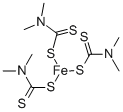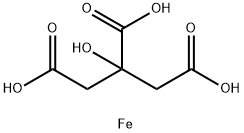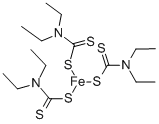FERBAM
- CAS NO.:14484-64-1
- Empirical Formula: C9H18FeN3S6
- Molecular Weight: 416.49
- MDL number: MFCD00067269
- EINECS: 238-484-2
- SAFETY DATA SHEET (SDS)
- Update Date: 2024-12-18 13:37:16

What is FERBAM?
Description
Ferbam is a combustible, odorless dark brownto black powder or granular solid. Molecularweight = 416.51; Freezing/Melting point = .180 C(decomposes). Hazard Identification (based on NFPA-704M Rating System): Health 2, Flammability 1, Reactivity 0.Practically insoluble in water; solubility = 0.01%.
Chemical properties
odourless black solid
Chemical properties
Ferbam is a combustible, odorless dark brown to black powder or granular solid
The Uses of FERBAM
Ferbam is a protective fungicide applied to foliage to control scab on pome fruit, peach leaf curl, blue mould on tobacco and other diseases on many other crops. It is often used in combinations with other dithiocarbamates to extend the spectrum of activity.
The Uses of FERBAM
Fruit fungicide.
The Uses of FERBAM
Nonphytotoxic fungicide used to control scab on fruits and other crops.
Definition
A wettable powder containing 76% ferbam.
General Description
Ferbam is a carbamate fungicide. It is a stable, black powder and combustible and gives off irritating or toxic fumes (or gases) in a fire. Ferbam is incompatible with strong oxidants. It is used for foliar protectant against scab, rust, mould, and many fungal diseases on fruits, vegetables, melons, and ornamentals. Also, it works as a repellent towards Japanese beetles. The major uses of ferbam are in the control of apple scab and cedar apple rust, peach leaf curl, tobacco blue mould, and cranberry diseases. Ferbam is a broad-spectrum registered fungicide for the control of certain diseases in fruit trees, small fruit and berry crops, potatoes, ornamentals, conifers, and tobacco and for use on citrus, pome, stone fruits, and cranberries. Major areas of use include Florida, Massachusetts, New Jersey, and other countries. Ferbam is used as water-dispersible granule, 76WG.
Air & Water Reactions
Thio and dithiocarbamates slowly decompose in aqueous solution to form carbon disulfide and methylamine or other amines. Such decompositions are accelerated by acids.
Reactivity Profile
FERBAM is a dithiocarbamate. Flammable gases are generated by the combination of thiocarbamates and dithiocarbamates with aldehydes, nitrides, and hydrides. Thiocarbamates and dithiocarbamates are incompatible with acids, peroxides, and acid halides.
Hazard
Irritant to eyes and mucous membranes. Questionable carcinogen.
Health Hazard
Ferbam is an irritant of the eyes and respiratory tract; in animals it causes central nervous system depression, and it is expected that severe exposure will cause the same effect in humans.
Flammability and Explosibility
Not classified
Agricultural Uses
Fungicide: Registered for use in the U.S. and Canada. Not approved for use in EU countries. A dimethyl-dithiocarbamate fungicide. It is widely used, together with other fungicides, to control Postbloom Fruit Drop (PFD) on citrus crops, and as a foliar protectant against scab, rust, mold and many fungus disease on fruits, vegetables, melons and ornamentals. It is registered in several states for use on currents and gooseberries to control leaf spot disease, and on apple, crabapple, hawthorn and quince to control cedar-apple rust disease. It is used to control rust disease on shrubs and ornamentals.
Trade name
AI3-14689®; AAFERTIS®; APPLE DUST No. 1®[C]; BERCEMA FERTAM 50®; CASWELL No. 458®; FERBAM 50®; FERBECK®; FERMATE FERBAM FUNGICIDE®[C]; FERMOCIDE®; FERRADOUR®; FERRADOW®; FUKLASIN ULTRA®; HEXAFERB®; HOKMATE®; KARBAM BLACK®; KARBAM CARBAMATE®; KNOCKMATE®; NIACIDE®; STAUFFER FERBAM®; SUP’R-FLO FERBAM FLOWABLE®; TRICARBAMIX®[C]; TRIFUNGOL®; VANCIDE FE95®[C]
Safety Profile
Poison by intraperitoneal route. Moderately toxic by ingestion. Experimental teratogenic and reproductive effects. Questionable carcinogen with experimental carcinogenic and tumorigenic data. Mutation data reported. A fungicide. When heated to decomposition it emits very toxic fumes of NOx and SOx. See also CARBAiMATES.
Potential Exposure
A dithiocarbamate. A potential danger to those involved in the production, formulation and application of this dithiocarbamate; used as a fungicide, rubber accelerator, and plastics prodegradant. Some dithiocarbamates have been used as rubber components
First aid
If this chemical gets into the eyes, remove anycontact lenses at once and irrigate immediately for at least15 min, occasionally lifting upper and lower lids. Seek medical attention immediately. If this chemical contacts theskin, remove contaminated clothing and wash immediatelywith soap and water. Seek medical attention immediately. Ifthis chemical has been inhaled, remove from exposure,begin rescue breathing (using universal precautions, including resuscitation mask) if breathing has stopped and CPR ifheart action has stopped. Transfer promptly to a medicalfacility. When this chemical has been swallowed, get medical attention. Give large quantities of water and inducevomiting. Do not make an unconscious person vomit.
Environmental Fate
Plant. Decomposes in plants to ethylene thiourea, ethylene thiuram monosul?de, ethylene thiuram disul?de and sulfur (Hartley and Kidd, 1987).
Chemical/Physical. Hydrolyzes in acidic media releasing carbon disul?de. Decomposes in water forming ethylene thiourea (Hartley and Kidd, 1987).
Decomposes >180°C (Windholz et al., 1983) emitting toxic fumes of nitrogen and sulfur oxides (Lewis, 1990; Sax and Lewis, 1987).
Metabolic pathway
Ferbam generates dimethyldithiocarbamic acid by being cleaved in acidic conditions and in biological media. The acid is conjugated with glucose and alanine in plants and with glucuronic acid in mammals. Dimethyldithiocarbamic acid is further degraded to dimethylamine and CS2. An extensive review of the properties of the dithiocarbamate pesticides was published by the World Health Organisation (WHO, 1988) from which much of the following information is taken.
storage
Color Code—Blue: Health Hazard/Poison: Storein a secure poison location. Prior to working with thischemical you should be trained on its proper handling andstorage. Ferbam is incompatible with strong oxidizers (suchas chlorine, bromine, and fluorine). Store in tightly closedcontainers in a cool, well-ventilated area away from oxidizers, strong bases and from heat and moisture. Ferbam candecompose upon long-term storage.
Shipping
UN2771 Dithiocarbamate and Thiocarbamate pesticides, solid, toxic, Hazard Class: 6.1; Labels: 6.1-Poisonous materials. UN3077 Environmentally hazardous substances, solid, n.o.s., Hazard class: 9; Labels: 9-Miscellaneous hazardous material, Technical Name Required
Degradation
Ferbam is hydrolysed in acidic media forming dimethyldithiocarbamic acid (2) that in turn decomposes to liberate carbon disulfide (PM) (see Scheme 1).
Incompatibilities
Incompatible with oxidizers (chlorates, nitrates, peroxides, permanganates, perchlorates, chlorine,bromine, fluorine, etc.); contact may cause fires or explosions. Keep away from alkaline materials, strong bases, strong acids, oxoacids, epoxides. Heat alkalies (lime); moisture can cause decomposition. Decomposes on prolonged storage. Dithiocarbamate esters are combustible. They react violently with powerful oxidizers such as calcium hypochlorite. Poisonous gases are generated by the thermal decomposition of Dithiocarbamate compounds, including carbon disulfide, oxides of sulfur, oxides of nitrogen, hydrogen sulfide, ammonia, and methylamine. Thio and dithiocarbamates slowly decompose in aqueous solution to form carbon disulfide and methylamine or other amines. Such decompositions are accelerated by acids. Flammable gases are generated by the combination of dithiocarbamate with aldehydes, nitrides, and hydrides. Dithiocarbamate are incompatible with acids, peroxides, and acid halides.
Waste Disposal
Ferbam is hydrolyzed by alkali and is unstable to moisture, lime and heat. Ferbam can be incinerated. In accordance with 40CFR165, follow recommendations for the disposal of pesticides and pesticide containers. Must be disposed properly by following package label directions or by contacting your local or federal environmental control agency, or by contacting your regional EPA office. Consult with environmental regulatory agencies for guidance on acceptable disposal practices. Generators of waste containing this contaminant (≥100 kg/mo) must conform with EPA regulations governing storage, transportation, treatment, and waste disposal
Properties of FERBAM
| Melting point: | 180°C (dec.) |
| Density | 0.21[at 20℃] |
| vapor pressure | 2 x 10-11 Pa (est.) |
| storage temp. | 0-6°C |
| solubility | DMSO (Slightly) |
| form | solid |
| Water Solubility | 130 mg l-1 (room temperature) |
| color | Black |
| Hydrolytic Sensitivity | 4: no reaction with water under neutral conditions |
| Merck | 14,4013 |
| Exposure limits | NIOSH 10 mg/m3, IDLH 800 mg/m3; OSHA PEL: TWA 15 mg/m3; ACGIH TLV: TWA 10 mg/m3. |
| Stability: | Stable. Incompatible with strong oxidants. |
| CAS DataBase Reference | 14484-64-1 |
| IARC | 3 (Vol. 12, Sup 7) 1987 |
| EPA Substance Registry System | Ferbam (14484-64-1) |
Safety information for FERBAM
| Signal word | Warning |
| Pictogram(s) |
 Skull and Crossbones Acute Toxicity GHS06  Exclamation Mark Irritant GHS07  Health Hazard GHS08  Environment GHS09 |
| GHS Hazard Statements |
H302:Acute toxicity,oral H315:Skin corrosion/irritation H319:Serious eye damage/eye irritation H330:Acute toxicity,inhalation H335:Specific target organ toxicity, single exposure;Respiratory tract irritation H361:Reproductive toxicity H373:Specific target organ toxicity, repeated exposure H410:Hazardous to the aquatic environment, long-term hazard |
| Precautionary Statement Codes |
P201:Obtain special instructions before use. P202:Do not handle until all safety precautions have been read and understood. P260:Do not breathe dust/fume/gas/mist/vapours/spray. P261:Avoid breathing dust/fume/gas/mist/vapours/spray. P264:Wash hands thoroughly after handling. P264:Wash skin thouroughly after handling. P270:Do not eat, drink or smoke when using this product. P271:Use only outdoors or in a well-ventilated area. P273:Avoid release to the environment. P280:Wear protective gloves/protective clothing/eye protection/face protection. P284:Wear respiratory protection. P391:Collect spillage. Hazardous to the aquatic environment P305+P351+P338:IF IN EYES: Rinse cautiously with water for several minutes. Remove contact lenses, if present and easy to do. Continuerinsing. P308+P313:IF exposed or concerned: Get medical advice/attention. P405:Store locked up. P403+P233:Store in a well-ventilated place. Keep container tightly closed. P501:Dispose of contents/container to..… |
Computed Descriptors for FERBAM
| InChIKey | WHDGWKAJBYRJJL-UHFFFAOYSA-K |
New Products
Tert-butyl bis(2-chloroethyl)carbamate 4-Methylphenylacetic acid N-Boc-D-alaninol N-BOC-D/L-ALANINOL N-octanoyl benzotriazole 3-Morpholino-1-(4-nitrophenyl)-5,6-dihydropyridin- 2(1H)-one Furan-2,5-Dicarboxylic Acid DIETHYL AMINOMALONATE HYDROCHLORIDE 1,1’-CARBONYLDIIMIDAZOLE R-2-BENZYLOXY PROPIONIC ACID 1,1’-CARBONYLDI (1,2-4 TRIAZOLE) N-METHYL INDAZOLE-3-CARBOXYLIC ACID (2-Hydroxyphenyl)acetonitrile 4-Bromopyrazole 5-BROMO-2CYANO PYRIDINE 5,6-Dimethoxyindanone 5-broMo-2-chloro-N-cyclopentylpyriMidin-4-aMine 2-(Cyanocyclohexyl)acetic acid 4-methoxy-3,5-dinitropyridine 1-(4-(aminomethyl)benzyl)urea hydrochloride 2-aminopropyl benzoate hydrochloride diethyl 2-(2-((tertbutoxycarbonyl)amino) ethyl)malonate tert-butyl 4- (ureidomethyl)benzylcarbamate Ethyl-2-chloro((4-methoxyphenyl)hydrazono)acetateRelated products of tetrahydrofuran








You may like
-
 Iron(III) Dimethyldithiocarbamate CAS 14484-64-1View Details
Iron(III) Dimethyldithiocarbamate CAS 14484-64-1View Details
14484-64-1 -
 1975-50-4 98%View Details
1975-50-4 98%View Details
1975-50-4 -
 2-HYDROXY BENZYL ALCOHOL 98%View Details
2-HYDROXY BENZYL ALCOHOL 98%View Details
90-01-7 -
 2-Chloro-1,3-Bis(Dimethylamino)Trimethinium Hexafluorophosphate 221615-75-4 98%View Details
2-Chloro-1,3-Bis(Dimethylamino)Trimethinium Hexafluorophosphate 221615-75-4 98%View Details
221615-75-4 -
 61397-56-6 CIS BROMO BENZOATE 98%View Details
61397-56-6 CIS BROMO BENZOATE 98%View Details
61397-56-6 -
 14714-50-2 (2-Hydroxyphenyl)acetonitrile 98+View Details
14714-50-2 (2-Hydroxyphenyl)acetonitrile 98+View Details
14714-50-2 -
 118753-70-1 98+View Details
118753-70-1 98+View Details
118753-70-1 -
 733039-20-8 5-broMo-2-chloro-N-cyclopentylpyriMidin-4-aMine 98+View Details
733039-20-8 5-broMo-2-chloro-N-cyclopentylpyriMidin-4-aMine 98+View Details
733039-20-8